Abgs Made Easy for Nurses With Tic Tac Toe
Don't you love ABG issues in nursing school? Well, I didn't until my professor taught us theTIC TAC TOE Method for ABGs and so solving ABG problems really started to be somewhat fun. Beneath I bear witness y'all how to solve ABG problems using the Tic Tac Toe method. In that location is likewise another method called the ROME method that you can employ to solve ABG problems.
After you read and watch the video on using the Tic Tac Toe Method, don't forget to that the ABG'south exercise quiz to exam your cognition.
In addition, you may exist interested in:
- Dosage & Calculation Bug in Nursing School
- Respiratory Acidosis vs Respiratory Alkalosis
Why Learn How to Interpret Arterial Claret Gases as Nurse?
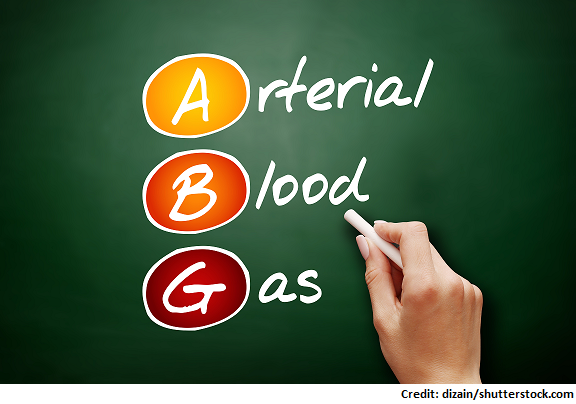 Being able to interpret Arterial Blood Gases (ABGs) as a nurse is very important. Many new nurses feel they are not comfortable with interpreting ABGs after they graduate. Some of these nurses feel they will never use information technology in their job and feel information technology is the respiratory therapist'south chore or notice it's too confusing to sympathise.
Being able to interpret Arterial Blood Gases (ABGs) as a nurse is very important. Many new nurses feel they are not comfortable with interpreting ABGs after they graduate. Some of these nurses feel they will never use information technology in their job and feel information technology is the respiratory therapist'south chore or notice it's too confusing to sympathise.
However, as the nurse taking intendance of the patient with aberrant Arterial Claret Gases (ABGs) it is your responsibleness to know what to report to the doctor and how to properly oxygenate your patient based on their ABGs.
Luckily there is a super easy style to help you interpret ABGs and I want to share information technology with you lot beneath.
Easy Way on How to Translate Arterial Claret Gases ABGs with Tic Tac Toe
First, we demand to lay the foundation and talk nigh what three lab values you need to look at when trying to figure out ABGs, how to determine if that value is consider normal, an acrid, or basic (alkalotic), and what fancy terms are used in one case the ABG is figured out.
Sentry this video I made on how to use the TIC TAC TOE Method for solving Arterial Blood Gases. Don't forget to subscribe to my YouTube channel for more teaching videos.
Explanation & Examples on Solving ABGs Problems
Below are the terms used to label abnormal ABG results:
- Respiratory Acidosis (uncompensated, partially compensated, or fully compensated)
- Respiratory Alkalosis (uncompensated, partially compensated, or fully compensated)
- Metabolic Acidosis (uncompensated, partially compensated, or fully compensated)
- Metabolic Alkalosis (uncompensated, partially compensated, or fully compensated)
When y'all are analyzing ABG results there are 3 things to await for when trying to find out if your patient is in respiratory or metabolic acidosis or alkalosis. Here they are and their normal numeric values (commit them to retentiveness):
- pH: 7.35-7.45
- CO2: 35-45 (CO2 lab value ALWAYS indicates a RESPIRATORY effect)
- HCO3: 22-26 (HCO3 lab value Always indicates a METABOLIC issue)
At present to determine when these values are considered an acid or base of operations. For pH anything less than 7.35 is an acrid and anything greater than seven.45 is a base. For CO2 (Notation: it is the opposite) anything less than 35 is a base and anything greater than 45 is an acid. For HCO3 annihilation less than 22 is an acid and anything greater than 26 is a base of operations. Here is a guide to assistance you lot empathise information technology:
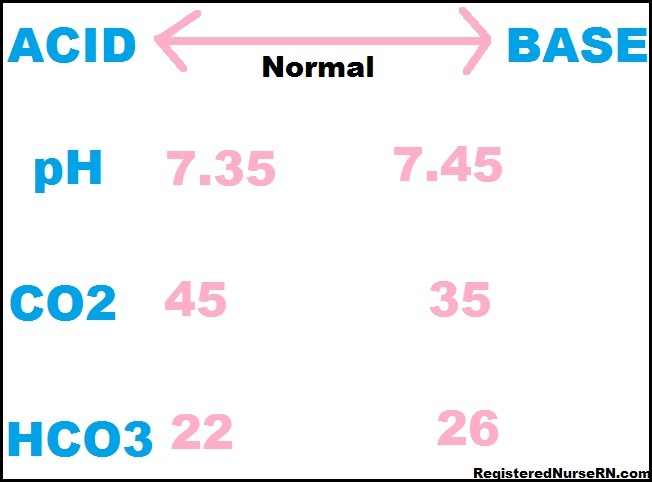
Permit's talk almost blood pH for a moment because if Full compensation presents at that place will Non be a tic tac toe and you will have to look closely at the claret pH to decide which system is causing the issue and which system is trying to "set up" the issue (hence compensate).
A normal blood pH is 7.35-7.45. The absolute normal is seven.40. Whatever normal blood pH that falls betwixt seven.35-seven.40 is NORMAL but on the "acidotic" side and whatever normal blood pH that falls betwixt seven.twoscore-7.45 is on the "alkalotic" side. This is illustrated below: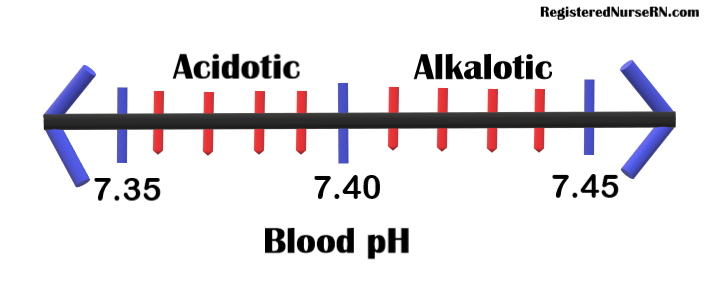
In order to utilise the tic tac toe method yous must first get a sail of paper and set upwardly a "tic tac toe" grid. Then label each "column" as "acrid", "pH", and "base". It should look like this:

Now lets solve a problem using the tic tac toe method: ABG results are the following…..pH 7.24, PCO2 75, HCO3 28
- Draw your tic tac toe lay out.
- Analyze your pH. Ask yourself is it normal, basic, or acidic? Since the pH is less than 7.35 making information technology an acid, place information technology nether the acrid cavalcade.
- Analyze your PCO2. Ask yourself is it normal, basic, or acidic? Since the PCO2 is greater than 45 making it an acid, place information technology nether the acid cavalcade forth with pH. Remember PCO2 is the reverse and the normal is 35-45.
- Analyze your HCO3. Ask yourself is information technology normal, basic, or acidic? Since HCO3 is greater than 26 making it basic, place it under the base column considering the value is considered basic.
- Your tic tac toe lay out should expect like this:
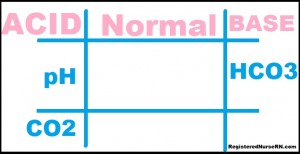
Now that you lot have your tic tac toe grid prepare. You need to figured out what you lot have. Since your pH is acidic you know that you have acidosis going on but is it respiratory or metabolic acidosis? Since CO2 represent respiratory and information technology is under the acid column with your pH you lot have respiratory acidosis going on.
Just is it fully compensated, partially compensated, or uncompensated respiratory acidosis? Look at your HCO3! Since your HCO3 is under basic, the metabolic system is trying to balance the body's organization out by becoming bones so information technology is partially compensating. And so the answer is Partially Compensated Respiratory Acidosis. Note: If HCO3 was under the normal cavalcade it would not be trying to compensated and therefore information technology would be considered uncompensated respiratory acidosis.
Permit's try another i: ABG results are: pH 7.l, PCO2 36, HCO3 32. Hither is what your tic tac toe grid should look similar:

- Analyze your pH. Inquire yourself is it normal, bones, or acidic? Since the pH is greater than 7.45 making it a basic, identify it under the base cavalcade.
- Analyze your PCO2. Enquire yourself is it normal, basic, or acidic? Since the PCO2 is betwixt 35-45 it is normal, place it under the normal column.
- Analyze your HCO3. Enquire yourself is information technology normal, basic, or acidic? Since HCO3 is greater than 26 making it basic, place information technology under the base column considering the value is considered basic.
- Since your pH is bones you know you have some alkalosis going on. But is information technology respiratory or metabolic? Since the HCO3 (which represents metabolic) is under you bones column with pH it is a metabolic outcome. Then your patient is in: Metabolic Alkalosis.
- Now is it fully compensated, partially compensated, or uncompensated metabolic alkalosis? Await at the CO2! Since information technology is under the normal column that ways the CO2 has Not tried to assist out the torso'due south system past making itself acidic. And then the body is not compensating.
- Answer: Uncompensated Metabolic Alkalosis
Let's try some other problem:claret pH seven.37, PaCO2 33, and HCO3 17….tic tac toe should expect similar this:

Pull once again for your retentivity banking company to analyze the values. You should determine this:
pH: vii.37 (falls within 7.35-vii.45) = NORMAL just it's on the acidotic side
PaCO2: 33 (less than 35) = ALKALOTIC
HCO3: 17 (less than 22) = ACIDIC
So, we don't accept a tic tac toe, therefore, the values are representing bounty (is it partial or total?).
To determine the type of compensation look at the pH…is it normal or abnormal? It's NORMAL! Therefore, we take total compensation.
BUT is this a respiratory or metabolic problem?
To make up one's mind this, await at the blood pH:
The blood pH is normal, but it falls on the acidotic side. Our metabolic system is also acidotic but our respiratory system is alkalotic. The problem is with the metabolic system and the respiratory system is trying to balance out the blood's acidotic state past decreasing the carbon dioxide level (PaCO2) to make things more alkaline, which will help increase the claret's pH from information technology's acidotic state….which is has and this is why nosotros have full bounty rather than partial. Note: If the pH was not normal and the HCO3 was withal acidotic, it would be partial bounty. On the flip side, if the pH was not normal merely the HCO3 was normal, it would be uncompensated.
Our respond is: metabolic acidosis, fully compensated past the ways of respiratory alkalosis
ABG Do Quiz
Do you desire to encounter how well yous know how to interpret ABGs? Hither is a free ABG practise test.
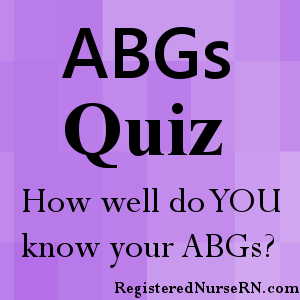
Source: https://www.registerednursern.com/arterial-blood-gas-interpretation-for-nurses-and-nursing-students/

0 Response to "Abgs Made Easy for Nurses With Tic Tac Toe"
Post a Comment